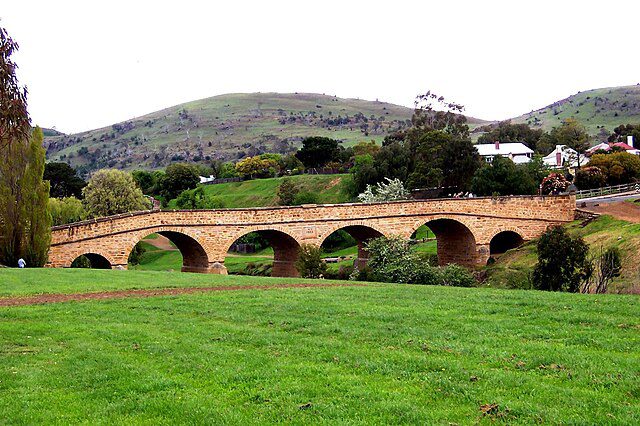
Richmond Bridge, nestled in the charming village of Richmond in Tasmania, is a marvel of engineering and history. As Australia’s oldest surviving stone arch bridge, it has stood the test of time for over 190 years. But this bridge is more than just a functional structure; it is a symbol of Tasmania’s colonial past, built by convicts under harsh conditions. Its beauty and durability continue to draw visitors from around the world, who come not only for its scenic charm but also for the stories it holds.
From the early 19th century, Richmond Bridge has played a vital role in Tasmania’s infrastructure, connecting communities and aiding in the growth of the colony. However, beneath the surface of its sturdy stone arches lies a fascinating history filled with myths, mysteries, and hard labor. This article delves deep into the story of Richmond Bridge, exploring its construction, the legends that surround it, and why it remains a significant landmark in Australian history.
The History of Richmond Bridge: Built to Last
Richmond Bridge was built between 1823 and 1825, during a period when Tasmania (then known as Van Diemen’s Land) was a convict settlement. The bridge was commissioned to improve transportation and communication between the growing settlements of Hobart and Port Arthur. At that time, the area around Richmond was a bustling hub for the colony’s agricultural production, and the bridge became essential for transporting goods.
Constructed by convicts, Richmond Bridge is a testament to their skill and endurance. The bridge spans the Coal River and was made from sandstone quarried nearby. The conditions under which the convicts worked were harsh, with long hours and little rest. However, their craftsmanship has stood the test of time, as the bridge remains in remarkable condition nearly two centuries later.
The bridge originally served a purely practical purpose, but over time it has become much more than that. It is now a symbol of Tasmania’s colonial heritage and the convict labor that helped shape the early infrastructure of Australia. The bridge’s role in connecting communities, both physically and symbolically, cannot be understated. Today, it serves as a reminder of a complex past, blending beauty with the brutal realities of convict life.
Despite being built for function, Richmond Bridge has achieved a status that few pieces of infrastructure ever do. Its elegant arches and picturesque setting have made it a favorite subject for photographers and artists alike. It is more than just a road—it’s a piece of living history, offering a glimpse into Tasmania’s early days as a penal colony.
Architectural Marvel: How Richmond Bridge Stands the Test of Time
The design of Richmond Bridge is a classic example of 19th-century stone arch architecture. At the time of its construction, such engineering was considered advanced, especially in a remote colony like Tasmania. The bridge consists of five main arches, with a total length of 41 meters (135 feet). The arches are semi-circular, a design that distributes weight evenly and provides the strength needed to support heavy loads.
The materials used in the construction of Richmond Bridge also contribute to its durability. The sandstone, quarried from nearby hills, has weathered remarkably well over the years. This local stone was not only abundant but also well-suited to the climate and conditions of the area. The choice of material, combined with the skill of the convict builders, resulted in a structure that has endured for nearly two centuries with minimal restoration work.
One of the key reasons Richmond Bridge has stood the test of time is the method used to construct its arches. Stone arches distribute the weight of the bridge and any loads it carries along the curve of the arch, reducing pressure on any single point. This method, combined with the use of durable materials, has allowed the bridge to survive floods, heavy use, and even changes in transportation over the years.
In comparison to modern bridges, which often use steel and concrete, Richmond Bridge stands out as a remarkable example of craftsmanship. It was built in a time when tools were simpler, and much of the work had to be done by hand. Yet, despite the limited technology available to the builders, they created a structure that has outlasted many more recent constructions. This speaks not only to the skills of the workers but also to the enduring appeal of traditional methods of construction.
Legends, Myths, and Ghost Stories: What Lurks Beneath the Bridge
Richmond Bridge is not only famous for its architectural significance but also for the many myths and legends that surround it. One of the most famous stories involves the ghost of a convict overseer named George Grover. According to local legend, Grover was known for his cruelty toward the convicts working on the bridge. It is said that he often beat them mercilessly and took pleasure in their suffering.
One night, after drinking heavily at a nearby tavern, Grover was found dead at the base of the bridge. Some say he was pushed by angry convicts seeking revenge, while others claim he fell accidentally. Regardless of how he died, many people believe his spirit still haunts the bridge. Over the years, numerous visitors have reported seeing a ghostly figure near the bridge, particularly on misty nights.
In addition to Grover’s ghost, there are other eerie stories associated with Richmond Bridge. Some locals believe that the bridge is cursed because of the suffering of the convicts who built it. There have been reports of strange noises coming from beneath the arches, as well as unexplained cold spots that seem to appear out of nowhere. While these tales may be exaggerated, they add an extra layer of intrigue to an already fascinating landmark.
Whether or not the stories of hauntings are true, they have certainly contributed to Richmond Bridge’s mystique. The bridge has become a popular destination for ghost hunters and those interested in the paranormal. Even for those who don’t believe in ghosts, the atmosphere around the bridge—especially at night—can feel otherworldly. The combination of history, legend, and mystery makes Richmond Bridge a must-visit spot for anyone traveling to Tasmania.
Richmond Bridge in Pop Culture: More Than Just a Historical Monument
Richmond Bridge is more than just a historical artifact; it has become a symbol of Tasmania itself. Over the years, it has appeared in numerous works of art, from paintings and photographs to literature and film. The bridge’s iconic arches and serene setting have made it a favorite subject for artists looking to capture the beauty of Tasmania’s landscape.
In the world of photography, Richmond Bridge is often featured in postcards and travel guides, showcasing its picturesque charm. The bridge’s reflection in the still waters of the Coal River creates a mirror-like effect that draws photographers from around the world. It’s not uncommon to see tourists and locals alike stopping by to capture the perfect shot, especially during the golden hour when the light casts a warm glow over the sandstone.
The bridge has also made its way into film and television, often being used as a backdrop for historical dramas and documentaries about Tasmania’s convict past. Its timeless appearance makes it an ideal setting for period pieces, as it has changed very little since it was first built. In this way, Richmond Bridge continues to play a role in storytelling, connecting the past with the present.
Beyond the world of art and media, Richmond Bridge has become a cultural icon in Tasmania. It’s a symbol of endurance, resilience, and the craftsmanship of the convict laborers who built it. For many Tasmanians, the bridge represents their connection to the island’s history and their pride in the achievements of their ancestors. As such, it’s not just a structure but a living part of Tasmania’s cultural heritage.
Richmond Village: More Than Just a Bridge
Richmond Bridge may be the star attraction, but the village of Richmond itself is worth exploring. Richmond is one of Tasmania’s best-preserved colonial villages, with many of its buildings dating back to the early 19th century. Visitors who come to see the bridge often find themselves enchanted by the charm of the village and its rich history.
One of the most notable landmarks in Richmond is St. John’s Church, which is just a short walk from the bridge. Built in 1836, it is Australia’s oldest Catholic church still in use today. The church’s simple yet elegant design complements the historic surroundings, and its cemetery holds the graves of many early settlers and convicts, adding another layer of history to the village.
Another important site is the Richmond Gaol, which was built in 1825 and is one of Australia’s oldest prisons. Like the bridge, the gaol was constructed by convicts and played a key role in the region’s history. Today, visitors can tour the prison and learn about the harsh conditions faced by the convicts who were held there. The gaol offers a sobering look at the realities of life in early Tasmania, providing context for the bridge’s construction.
In addition to its historical sites, Richmond is known for its boutique shops, cafes, and galleries. The village has become a popular destination for tourists looking to experience Tasmania’s history while enjoying the quaint, small-town atmosphere. With its combination of natural beauty and historical significance, Richmond offers visitors a chance to step back in time and explore Tasmania’s colonial past.
The Role of Convict Labor in Richmond Bridge’s Construction
The story of Richmond Bridge cannot be told without discussing the role of convict labor in its construction. During the early 19th century, convicts were sent to Tasmania as part of Britain’s penal transportation system. Many of these convicts were skilled laborers, including stonemasons and builders, whose expertise was used to construct much of Tasmania’s early infrastructure.
Richmond Bridge is one of the many convict-built structures that still stand today, a testament to the skill and hard work of these men. The convicts who worked on the bridge were not just manual laborers; many of them had been trained in their trades before being transported to Tasmania. Despite the harsh conditions they endured, they were able to create a structure that has stood the test of time.
The use of convict labor in Tasmania was a double-edged sword. On one hand, it allowed the colony to build infrastructure quickly and at a low cost. On the other hand, the convicts who built these structures often did so under brutal conditions. They worked long hours, received little food or rest, and were subjected to harsh punishments if they failed to meet the expectations of their overseers.
Richmond Bridge, like many convict-built structures, serves as a reminder of the hardships faced by those who were transported to Tasmania. It’s important to recognize the human cost behind these architectural achievements. Today, there is a growing appreciation for the role that convicts played in shaping Australia’s early history, and Richmond Bridge stands as a symbol of their resilience and skill.
How Richmond Bridge Has Withstood the Test of Time
Richmond Bridge’s remarkable condition after nearly two centuries is a testament to both the quality of its construction and the efforts to preserve it. Over the years, there have been several restoration projects aimed at maintaining the bridge’s structural integrity while preserving its historical authenticity.
One of the key challenges in maintaining Richmond Bridge has been protecting it from environmental factors. The Coal River, which flows beneath the bridge, has flooded several times over the years. While the bridge has survived these floods, they have caused some erosion to the sandstone foundations. Preservation efforts have focused on reinforcing the bridge’s base and ensuring that it can withstand future environmental challenges.
In addition to environmental factors, the bridge has had to adapt to changes in transportation. When it was first built, Richmond Bridge was designed to accommodate horse-drawn carts and foot traffic. Today, it must support cars and other modern vehicles, which place much heavier loads on its arches. Engineers have taken steps to ensure that the bridge can handle these increased loads without compromising its structural integrity.
Despite these challenges, Richmond Bridge has remained largely unchanged since it was first built. Its preservation is a testament to the dedication of those who have worked to maintain it, as well as the skill of the convicts who built it. The bridge continues to serve as a vital part of Tasmania’s infrastructure while also standing as a historical monument that draws visitors from around the world.
A Tourist’s Guide to Richmond Bridge: Things to Know Before You Go
Richmond Bridge is one of Tasmania’s most popular tourist attractions, and for good reason. Its historical significance, combined with its picturesque setting, makes it a must-see for anyone visiting the region. If you’re planning a trip to Richmond Bridge, here are a few things you should know before you go.
First, the best time to visit Richmond Bridge is during the spring or autumn months, when the weather is mild and the surrounding landscape is at its most beautiful. Early mornings and late afternoons are ideal for photography, as the soft light enhances the bridge’s sandstone arches and creates stunning reflections in the Coal River.
When visiting the bridge, be sure to take some time to explore the surrounding area. Richmond village is full of historic buildings, quaint shops, and cafes where you can enjoy a relaxing meal. St. John’s Church and the Richmond Gaol are just a short walk from the bridge and are both worth a visit for those interested in Tasmania’s colonial history.
If you’re looking to stay overnight, there are several charming bed and breakfasts in Richmond, as well as nearby accommodation options in Hobart, which is just a 25-minute drive away. Richmond’s central location makes it an excellent base for exploring other parts of southern Tasmania, including the famous Port Arthur Historic Site.
Finally, don’t forget to bring a camera! Richmond Bridge is one of the most photographed landmarks in Tasmania, and it’s easy to see why. Whether you’re capturing the bridge’s arches or the surrounding countryside, you’ll want to take home a few memories of your visit.
The Enduring Legacy of Richmond Bridge
Richmond Bridge is more than just a piece of infrastructure; it’s a living part of Tasmania’s history. For nearly 200 years, it has served as a connection point—both literally and figuratively—between Tasmania’s past and present. The bridge’s beauty, durability, and historical significance have ensured that it remains a cherished landmark, not only for Tasmanians but for visitors from around the world.
The bridge’s legacy is one of resilience. Built by convicts under harsh conditions, it has withstood floods, changes in transportation, and the passage of time. It’s a symbol of the convict experience in Tasmania and a reminder of the role these individuals played in shaping the colony’s early infrastructure.
Today, Richmond Bridge continues to draw tourists, historians, and art lovers who are captivated by its story. It stands as a testament to the skill and determination of its builders and serves as a reminder of the complexities of Tasmania’s colonial past. As one of Australia’s oldest surviving structures, it holds a unique place in the country’s history.
As Charles Dickens once said, “The past is the beginning of the beginning and all that is and has been is but the twilight of the dawn.” Richmond Bridge embodies this sentiment perfectly, standing as a bridge not just between two sides of a river, but between two eras of history—one that shaped the foundation of modern Tasmania.




